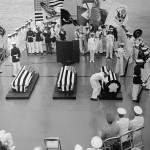On this Memorial Day it seems an appropriate time to share the story of the selection of the WWII Unknown Soldier – and of the burial at sea of another WWII unknown soldier.
The Unknown Soldier of WWII was not selected until 1958. Nineteen bodies of unknown American soldiers (thirteen from the European Theater of Operations and six from the Pacific Theater) were exhumed from cemeteries in Europe, Africa, the Philippines and Hawaii. All nineteen remains were placed in identical caskets. The European unknowns were shipped to the U.S. cemetery in Epinal, France. The Pacific unknowns were shipped to Hickam Air Force Base, Hawaii. One set of remains was selected from each Theater of Operation – the European unknown selected by an Army General and the Pacific unknown by an Air Force Colonel. The remains not selected were reburied in France and Hawaii. The two caskets remaining were eventually transferred to the U.S.S. Canberra, a guided-missle frigate resting outside the Virginia Capes, along with the Unknown Soldier of the Korean War, also selected in Hawaii from four unknowns from that conflict. Three morticians aboard the Canberra took turns changing the positions of the caskets of the WWII dead, each time alone in a closed space, in total secrecy. The Korean War Unknown Soldier was then placed on the deck of the Canberra, with the two remaining WWII unknowns placed on each side. To quote the official Arlington Cemetery account:
“Navy Hospitalman 1st Class William R. Charette, then the Navy’s only active-duty Medal of Honor recipient, selected the Unknown Soldier of World War II. The remaining casket received a solemn burial at sea.
It’s almost hard to comprehend the journey of the American soldier who was buried at sea from the U.S.S. Canberra that day. It has to be one of the strangest journeys to a final resting place in history. One can only contemplate the endless mystery. Where was he born and raised – the Kansas prairie, the Bronx, the Maine coast, the Arizona desert – or was he an immigrant from Naples or Dublin or Manila? Did he die at Normandy, Guadalcanal, Peleliu, or over the skies of Germany? Was he once buried next to his close comrades and his friends – or was he originally buried in a grave next to no one he ever knew? One thing is probably certain, however, the very instant before he died he never expected to be buried alone at sea off the Virginia Capes more than a decade later.
Navy Hospitalman 1st Class William R. Charette selects the Unknown Soldier of WWII on the deck of the U.S.S. Canberra (May 1958). The center casket contains the remains of the Korean War Unknown Soldier. The casket on the left would be buried at sea off the Virginia Capes.
Additional information on the selection of the WWII Unknown Soldier can be found at these two fascinating websites:
http://www.arlingtoncemetery.org/visitor_information/tomb_of_the_unknowns.html
http://www.arlingtoncemetery.net/unk-w2ko.htm

Carol Smith said:
Classic and beautifully done. How appropriate on this day to make the Arlington Memorial even more memorable.